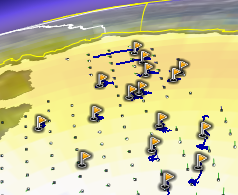So much news, so little time. Here we go…
Sell your KML scripting skills to the entertainment industry: “A major film studio” wants to use Google Earth to promote a movie, and they need your help.
Digitally Distributed Environments decides to use several of Microsoft’s “bird’s eye views” in Live Local to generate a real 3D map of a location. The result is a-m-a-z-i-n-g (check out the QT movie). If I am not mistaken, this is akin to the SilverEye technology that Geotango possesses and which Microsoft bought that company for.
How often is Google Earth mentioned on the internets? This much.
A blog to watch if you do GPS: Jeepx.
CNET asks, Where on Google Earth is this? Brand watchers among us, note how CNET did not ask “Where on MSN Live Local…”, “Where on World Wind…” (despite the lovely alliteration) or “Where on ESRI ArcGIS Explorer…”.
Talking of the competition: Matt Giger, maker of EarthBrowser, has just started blogging. So has Chris Maxwell, a lead developer of World Wind. And Bull’s Rambles, a new blog dedicated to “this and that, mainly World Wind rants” lives up to the promise of its tag line, offering up three reasons why the free version of Google Earth isn’t really free. (Can we really not take screenshots? :-)


